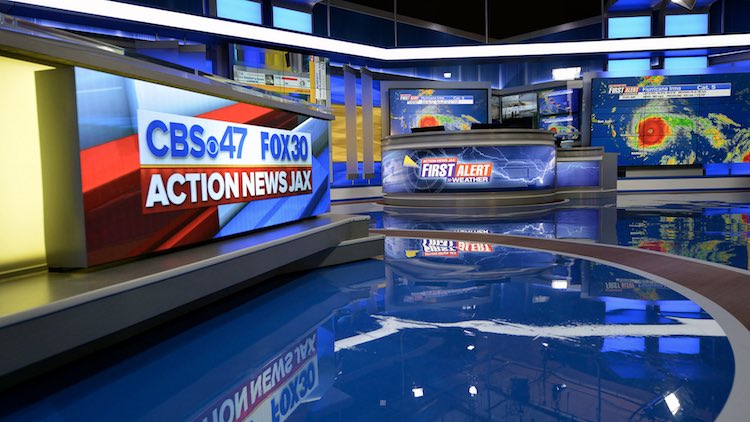
The main anchor desk uses a curved 1.5mm pixel-pitch LED display from HyperPixel.When Jacksonville, FL’s CBS affiliate WJAX TV began renovating its production studio, it wanted to incorporate an eye-catching display in every area of the set—including the anchor desk. Working with a design consultant, Advanced enthusiastically took on the challenge, delivering the installation of more than 40 displays by NEC, HyperPixel, and LG.
“The end result of this multi-faceted installation is truly stunning,” said Advanced vice president Mark McPherson. “No aspect was more challenging than the integration of a custom HyperPixel 1.5mm LED display into the primary anchor desk. Most studios use an LCD screen, if that—and we had to develop a way to configure and mount a super-fine pixel-pitch, direct-view LED display onto the curved surface. WJAX now has one of the most cutting-edge studios in broadcasting.”
Advanced’s engineering team planned out how exactly they’d build and configure a 6x1 panel anchor desk display. Advanced chose to work with HyperPixel because it could custom-configure the displays to work in portrait mode, making them compatible with the horizontal shape of the desk. “We requested that custom panels be made for this to work,” said Greg Priest, senior account manager at Advanced. “And, in addition to the displays themselves, HyperPixel designed special framing and mounting components to successfully secure them.”
Beyond the high-tech anchor desk, Advanced installed more than 40 displays throughout the studio. Advanced built the central 9x3 panel video wall and flanking 2x4 panel monitors with NEC’s ultra-thin bezel LCD displays because of their adaptability in the broadcast environment. “NEC displays look great on camera,” Preist said. “There are thin bezels on the models and that translate fantastically in this application. Additionally, NEC displays allow for fine color adjusting. Lighting is different in every studio, which affects on-screen color balancing. These displays make it easy to make very specific color adjustments in any given studio.”

NEC displays were used in the 9x3 central video wall because of their fine color adjusting. Since the set’s production is extremely video-centric, Advanced was also responsible for configuring the sophisticated signal processing system. Advanced relied on tvONE to integrate 12 different connectors into the production staff’s own switcher, allowing them to send 12 signals to various monitors throughout the studio. “We chose to work with a video processor that was easy for production staff to use,” McPherson said. “Staffers can break visuals into different windows, and distribute video content to the displays in a variety of configurations. It allows for total flexibility.”According to McPherson, the set was finished just in time for Jacksonville’s crucial coverage of Hurricane Irma in the region. “The new displays served as key disseminators of information throughout Hurricane Irma’s impact in Florida,” he said. “It’s exciting to see how displays can transform a news broadcast. The entire team is thrilled with the end result, and we’re very proud of the work we did for WJAX.”













